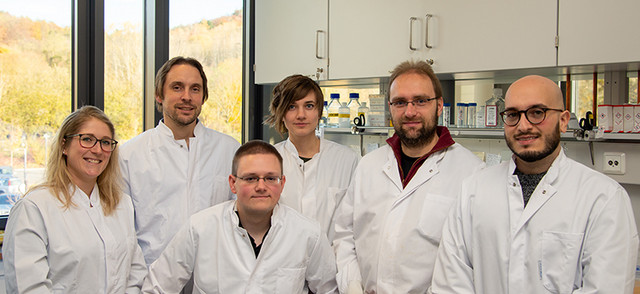Alexander Hahn, Dr. rer. nat.; Anna Großkopf, Dr. rer. nat.; Bojan Hörnich (Dr. rer. nat., nach abgeschlossener Doktorarbeit jetzt beim DLR).; Sarah Schlagowski, TA; Dr. Thomas Fricke (PhD); Stefano Scribano, M. Sc.
KSHV und RRV
Unsere Gruppe erforscht das humane Kaposi-Sarkom-Herpesvirus (KSHV), ein gamma2-Herpesvirus oder Rhadinovirus, und das verwandte Rhesusaffenrhadinovirus RRV. KSHV ist ein Tumorvirus. Es ist mit dem Kaposi-Sarkom assoziiert, sowie mit dem primären Effusionslymphom und der multizentrischen Castleman Erkrankung, zwei proliferativen B-Zell-Erkrankungen. Die KSHV-assoziierten Erkrankungen treten vor allem in Subsahara-Afrika und im Kontext von HIV Erkrankungen auf.
Virus-Rezeptor Interaktionen
Ein Schwerpunkt unserer Arbeit liegt auf der Interaktion der viralen Glykoproteine mit zellulären Rezeptoren. Die Rezeptorinteraktionen sind entscheidend für die Erkennung und Infektion von Zielzellen. Sie sind eine wichtige Determinante des Tropismus der Viren und bestimmen, welche Zelltypen und Gewebe das Virus infizieren kann. Wir nutzen unsere Erkenntnisse über spezifische Virus-Rezeptor Interaktionen, um Virusmutanten zu generieren, die mit bestimmten Rezeptoren nicht mehr interagieren können und einen veränderten Zell- und Gewebstropismus aufweisen. Auf lange Sicht wollen wir diese modifizierten Viren als experimentelle Impfviren und Impfvektoren nutzen.
Rezeptorfunktion
Ein weiterer Fokus unserer Forschung liegt auf der Funktion der zellulären Rezeptoren selbst. Der zelluläre Rezeptor des KSHV gH/gL Glykoproteinkomplexes, EphA2, sowie verwandte Proteine aus der Eph Familie werden von mehreren viralen und mindestens einem bakteriellen Pathogen genutzt. Kürzlich wurde entdeckt, dass sogar Malariaparasiten diesen Rezeptor binden. Wir denken, dass diese konvergente Evolution die Frage nahelegt, warum ein derart unterschiedliches Ensemble an Krankheitserregern mit dem gleichen Protein interagiert.
Epidemiologie, Übertragung und Krankheiten
Die DPZ Primatenkolonie stellt eine einzigartige Ressource für die Gewinnung und Analyse weiterer Virusisolate dar. Durch die Sequenzierung von Virusisolaten wollen wir die Sequenzvielfalt der Viren und die Übertragungsrouten in der Primatenkolonie erforschen. In Kollaboration mit der Abteilung Infektionspathologie können wir mögliche Assoziationen mit Erkrankungen aufspüren.
Ausgewählte Publikationen:
Liu S, Großkopf AK, Schlagowski S, Ensser A, Hahn AS; Kaposi's sarcoma-associated herpesvirus glycoprotein K8.1 is critical for infection in a cell-specific manner and functions at the attachment step on keratinocytes.
bioRxiv preprint doi: https://doi.org/10.1101/2023.03.19.533316
Fricke T, Schlagowski S, Liu S, Yang X, Fiebig U, Kaul A, Ensser A, Hahn AS. Comparison of a Genotype 1 and a Genotype 2 Macaque Foamy Virus env Gene Indicates Distinct Infectivity and Cell-Cell Fusion but Similar Tropism and Restriction of Cell Entry by Interferon-Induced Transmembrane Proteins.
Viruses. 2023 Jan 17;15(2):262. doi: 10.3390/v15020262.
Fricke T, Großkopf AK, Ensser A, Backovic M, Hahn AS; Antibodies Targeting KSHV gH/gL Reveal Distinct Neutralization Mechanisms. Viruses, 2022, 14 (3), 541
Hörnich BF, Großkopf AK, Dcosta CJ, Schlagowski S, Hahn AS; Interferon-Induced Transmembrane Proteins Inhibit Infection by the Kaposi’s Sarcoma-Associated Herpesvirus and the Related Rhesus Monkey Rhadinovirus in a Cell-Specific Manner. mBio. 2021 Dec 21;12(6):e0211321. doi: 10.1128/mBio.02113-21.
Großkopf AK, Schlagowski SC, Ensser A, Desrosiers RC, Hahn AS; Plxdc family members are novel receptors for the rhesus monkey rhadinovirus (RRV). PLoS Pathogens. 2021 Mar 03; 17(3): e1008979. doi: 10.1371/journal.ppat.1008979.
Hörnich BF, Großkopf AK, Schlagowski S, Tenbusch M, Kleine-Weber H, Neipel F, Stahl-Hennig C, Hahn AS; SARS-CoV-2 and SARS-CoV spike-mediated cell-cell fusion differ in the requirements for receptor expression and proteolytic activation. Journal of Virology. 2021 Feb 19;JVI.00002-21. doi: 10.1128/JVI.00002-21.
Ensser A, Yasuda K, Lauer W, Desrosiers RC, Hahn AS; Rhesus Monkey Rhadinovirus Isolated from Hemangioma Tissue. Microbiol Resour Announc. 2020 Mar 19;9(12). pii: e01347-19. doi: 10.1128/MRA.01347-19.
Hahn AS, Bischof GF, Großkopf AK, Shin YC, Domingues A, Gonzalez-Nieto L, Rakasz EG, Watkins DI, Ensser A, Martins MA, Desrosiers RC; A Recombinant Rhesus Monkey Deleted of Glycoprotein L Establishes Persistent Infection of Rhesus Macaques and Elicits Conventional T Cell Responses. J Virol. 2020 Jan 6;94(2). pii: e01093-19. doi: 10.1128/JVI.01093-19. Print 2020 Jan 6.
Großkopf AK, Schlagowski S, Hörnich BF, Fricke T, Desrosiers RC, Hahn AS; EphA7 functions as receptor on BJAB cells for cell-to-cell transmission of the Kaposi's sarcoma-associated herpesvirus (KSHV) and for cell-free infection by the related rhesus monkey rhadinovirus (RRV). J Virol. 2019 May 22. pii: JVI.00064-19. doi: 10.1128/JVI.00064-19.
Ensser A, Großkopf AK, Mätz-Rensing K, Roos C, Hahn AS; Isolation and sequence analysis of a novel rhesus macaque foamy virus isolate with a serotype-1-like env. Arch Virol. 2018 Sep;163(9):2507-2512. doi: 10.1007/s00705-018-3892-9.
Großkopf AK, Ensser A, Neipel F, Jungnickl D, Schlagowski S, Desrosiers RC, Hahn AS; A Conserved Eph Family Receptor-Binding Motif on the gH/gL Complex of Kaposi’s Sarcoma-Associated Herpesvirus and Rhesus Monkey Rhadinovirus. PLoS Pathogens, 2018, 2018 Feb 12;14(2):e1006912. doi: 10.1371
Hahn AS, Großkopf AK, Jungnickl D, Scholz B, Ensser A; Viral Fgarat Homolog ORF75 Of Rhesus Monkey Rhadinovirus Effects Proteasomal Degradation Of The ND10 Components SP100 And PML. Journal of Virology, 2016 Aug 12;90(17):8013-28.
Hahn AS, Desrosiers RC; Binding of the Kaposi's Sarcoma-Associated Herpesvirus to the Ephrin Binding Surface of the EphA2 Receptor and its Inhibition by a Small Molecule. Journal of Virology, 2014, 88(16):8724.
Hahn AS, Desrosiers RC; Rhesus monkey rhadinovirus uses Eph family receptors for entry into B cells and endothelial cells but not fibroblasts. PLoS Pathogens, 2013 May 16;9(5):e1003360.
Hahn AS, Kaufmann JK, Wies E, Naschberger E, Panteleev-Ivlev J, Schmidt K, Holzer A, Schmidt M, Chen J, König S, Ensser A, Myoung J, Brockmeyer NH, Stürzl M, Fleckenstein B, Neipel F; The ephrin receptor tyrosine kinase A2 is a cellular receptor for Kaposi’s sarcoma–associated herpesvirus. Nature Medicine, 2012 Jun;18(6):961-6.
Wies E*, Hahn AS*, Schmidt K, Viebahn C, Rohland N, Lux A, Schellhorn T, Holzer A, Jung JU, Neipel F; The Kaposi’s sarcoma-associated herpesvirus encoded vIRF-3 inhibits cellular IRF-5. Journal of Biological Chemistry, 2009 Mar 27;284(13):8525-38. * shared first authors
Hahn A, Birkmann A, Wies E, Dorer D, Mahr K, Stürzl M, Titgemeier F, Neipel F; Kaposi’s Sarcoma Associated Herpesvirus gH/gL: Glycoprotein Export and Interaction with Cellular Receptors. Journal of Virology, 2009 Jan 1;83(1):396-407.

Dr. Alexander Hahn Leiter der Nachwuchsgruppe +49 551 3851-337 Kontakt
Neuigkeiten
31.07.2019

